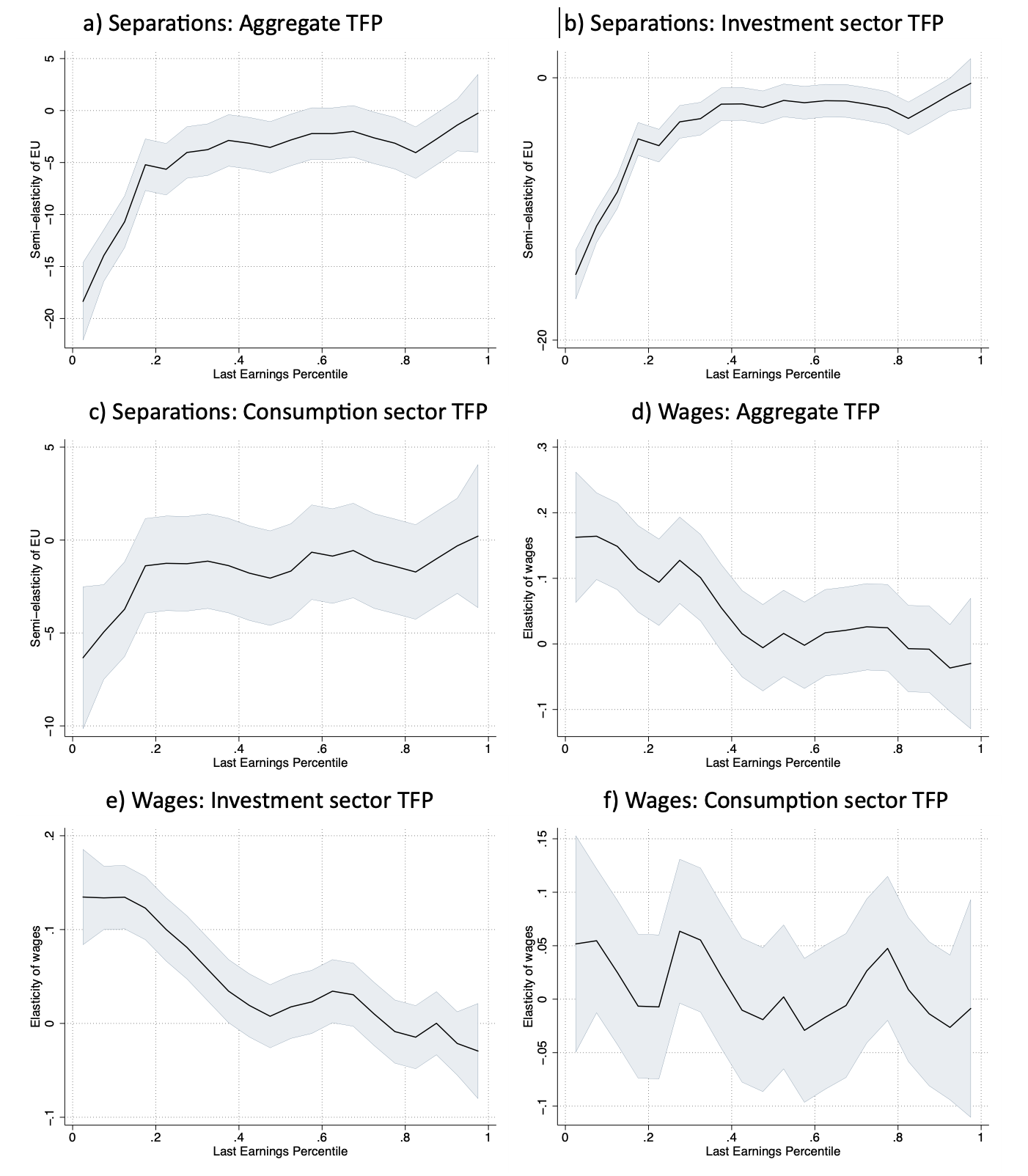Recent recessions, including those following the 2007-2008 financial crisis and the pandemic, have been marked by significant reallocation of workers (Foster et al. 2016), a decline in participation (BLS 2020), and an increase in earnings inequality in many countries (e.g. Blanchet et al. 2020). The adoption of recent technologies has contributed to the hollowing out of jobs and the increase in wage inequality through a reallocation of workers across sectors and jobs. Those facts provide a compelling case for studying the joint impact of reallocation on the cyclical fluctuations of job flows and on the dynamic of wage inequality.
The role of labour reallocation for inequality and the economy's response to technological changes has a long tradition in economics dating back to Schumpeter (1942). Much of the focus has been largely on the long-run consequences of reallocation across sectors, a process known as structural transformation (Herrendorf et al. 2013), and its implications for cyclical unemployment at aggregate level (Lilien 1982, Chodorow-Reich and Wieland 2020). Despite the fact that reallocation has clear distributional consequences, less attention has been devoted to its impact on the cyclical movements of the job flows along the income distribution and across workers with different skills. Furthermore, the recent emphasis on the task content of occupations and the impact of technology on it (Autor et al. 2003) calls for an examination of the reallocation process across jobs rather than across sectors: technological advances may indeed favour the shift toward specific jobs, but the skill upgrading needed to do the shift may make the process sluggish.
Our paper (Faia and Shabalina 2023) addresses these issues by jointly studying the heterogenous impact of reallocation for job flows – i.e. separations and gross flows – and for changes in wage growth along the income distribution, or else for the dynamic of wage inequality. We focus on the heterogeneous response of job flows and wage growth to technology shocks, as these have a direct impact on the labour market. Our findings are based on a time series analysis of job flows and we elaborate on the mechanism driving the results through the lens of a heterogenous agent model featuring occupational decisions.
First, using Current Population Survey (CPS) data on job flows (separations and gross flows) and wage growth over the sample period 1989-2019, we estimate their elasticities in response to aggregate and sectoral TFP shocks by conditioning on both the income percentile of the worker and the routine intensity of her/his job. Conditioning on the skill content of jobs is crucial in light of the large and growing evidence that links skill-biased or routine-biased technological change to inequality. CPS data are particularly well suited for a study on cyclical movements, even relative to administrative data, due to their availability at higher frequency. We employ local projection methods (Jorda 2005) to estimate the elasticities in response to externally identified aggregate and sectoral TFP shocks (Fernald 2014). The inclusion in the econometric specification of worker fixed effects allows us to purge for long-run or other life cycle components that may drive the response of job flows.
Figure 1 shows the results in terms of impact impulse response to aggregate and sectoral shocks of job separations and wage growth. Specifically, in each panel, the impact response of either separations or wage growth is plotted against the income ventiles, shown on the x-axis. We find that in the face of technological improvements (contractions), separations and job flows decline (increase) significantly for bottom earners and for routinary jobs, but not so for top earners. Correspondingly, wages increase (decline) more for bottom earners, while not significantly for top earners. An implication of this is that expansions, fueled by technological improvements, reduce wage inequality, while recessions increase it.
Figure 1 Impulse response to aggregate and sectoral shocks of job separations and wage growth
We also find that the impact of shocks on gross flows, our measure for reallocation across jobs, is stronger for workers whose earnings are below the median. In other words, adverse shocks are more likely to undermine the mobility of low-income workers toward jobs for which they have a higher comparative advantage or higher-paying jobs, thereby impairing their move towards opportunity. The impact of technology shock on separations is also stronger for workers employed in routine jobs – these are therefore the ones that are more exposed to business cycle fluctuations.
Economically, this speaks to a selection channel: in recessions, firms lay off the least productive workers; the larger decline in labour demand for those workers results in a larger decline in wages and earnings. This in turn reduces worker incentives to participate in the labour market and to move to jobs for which they have a higher comparative advantage or that offer higher pays. Our results are complementary to those presented in Tavares et al. (2002), who show that changes in wages following a change in occupation depend much on worker demographics and skills. Furthermore, a selection channel is uncovered also in vom Berge et al. (2021), albeit in response to labour market policies.
We then devise a general equilibrium model which combines consumption-saving decisions under uninsurable risk with participation and occupation choices and use it to interpret and quantify the channels that may explain the results. The combination of uninsurable risk and occupational choice is important to capture one of our main findings, namely the conditionality of the response of job flows to the income percentile. This can arise only in an environment in which workers cannot insure against shocks. Indeed, in the model, the probability of participating in the labour market and moving across jobs depends on the lifetime discounted utility, which in turn depends on the distribution of income in the absence of insurance. The skill intensity of occupations in the model is calibrated on ONET data and, through this, we are also able to cluster occupations based on routine intensity likewise in the data. Solving the model numerically, we show that model-simulated data can indeed replicate the elasticities estimated in the CPS data along income percentiles and across jobs with different degrees of routine intensity.
Our results may also have implications for fiscal policy. Highlighting which worker categories are more exposed to business cycle fluctuations may inform fiscal policy on how to design redistributive taxation or automatic stabilisers along the business cycle.
References
Autor, D, L Frank and M J Richard (2003), “The Skill Content of Recent Technological Change: An Empirical Exploration,” The Quarterly Journal of Economics 118 (4): 1279–1333.
Blanchet, T, E Saez and G Zucman (2022), “Real-time inequality”, NBER Working Paper 30229.
Bureau of Labor Statistics (2021), “Comparing labor force participation in the recovery from the 2020 recession with prior recessions”, The Economics Daily.
Chodorow-Reich, G and W Johannes (2020), “Secular Labor Reallocation and Business Cycles,” Journal of Political Economy 128 (6): 2245–2287.
Faia, E and E Shabalina (2023), “Cyclical Move to Opportunity”, CEPR Discussion Paper 18546.
Foster, L, G Cheryl and H Haltiwanger (2016), "Reallocation in the great recession: cleansing or not?", Journal of Labor Economics 34.S1: S293-S331.
Herrendorf, B, R Richard and A Valentinyi (2013), “Two perspectives on preferences and structural transformation,” American Economic Review 103(7): 2752–89.
Lilien, D M (1982), “Sectoral Shifts and Cyclical Unemployment,” Journal of Political Economy 90(4): 777–793.
Schumpeter, J (1942), Capitalism, Socialism, and Democracy, Harper and Brothers.
Tavares, M, I Shibata, C Francesca, H Niels-Jakob and J Bluedorn (2022), “The Unequal Effects of Labour Market Reallocation”, VoxEU.org, 6 October.
Vom Berge, P, M Umkehrer, A Lindner, U Schonberg and C Dustmann (2021), “Reallocation Effects of the Minimum Wages”, VoxEU.org, 7 October.




